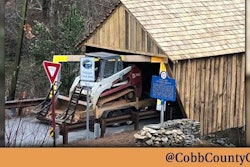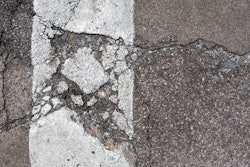
“There are still older machines out there, and some customers will buy new machines without the cab,” says Mark Stahl, recycling products manager at Wirtgen, which introduced its first recyclers, featuring standard enclosed cabs, in 1995. “You see that with recyclers; you see that with rollers; you see that with some dirt equipment. But I would say industrywide, the trend is definitely going toward the enclosed cab.”
There’s no question that the environment for recyclers in either stabilization jobsites or recycling jobsites is plenty dirty, with hazards such as the small, respirable, silica particles that can cause the lung disease silicosis.
“Typically, a contractor is applying a cement or lime to soils, so they’re putting down an additive in a powder form that’s very dusty; it gets caught in the wind, and it’s all around the personnel onsite,” says Stahl. “When the recycler is driven on top of this layer of powder, it stirs up dust as the machine travels in it. And then when the recycler engages with that material and the soils produce a stabilized base, that process generates dust as well.
“Being exposed to this environment on a continual basis is not healthy for personnel. As we’re seeing regulations in construction and other industries come out, they’re trying to eliminate a lot of those health hazards, so the cab design just makes sense.”
Roadtec’s SX-8 soil stabilizer-reclaimer addresses this with a cooling system that pulls air from the top of the machine before it is exhausted through the radiator package. This design reduces the amount of dust traveling though the cooling system, the company says.
Cab climate control shields operators from sweltering temperatures, direct sun and other elements, when most of these machines are running.
Wirtgen’s cab is mostly glass to increase visibility, Stahl notes. The cab slides hydraulically from side to side, so if an operator wants to look down the left or right side of the machine, he or she can extend the cab over the edge of the frame. The comfortable driver’s seat, which has air and spring systems, swivels 90 degrees along with the steering column and armrest.
“The reasons for the design of the cab are to decrease the health hazards to the operator, increase the safety for the operator and the crew working around the machine, and ultimately, increase production,” Stahl says.
Similarly, at BOMAG the trend with its recycler and soil stabilizer machines continues to focus on advancing safety, productivity and gradation quality, says Dave Dennison, manager of marketing services.
Recently introduced features on BOMAG’S machines address product quality, operator safety and comfort, he says.
Caterpillar’s RM500B has an ISO-mounted cab that reduces vibration and is pressurized to keep out noise, dust and the elements, according to Mark Eiden, Caterpillar global sales consultant. The RM500B is designed for both full-depth road reclamation projects and soil stabilization jobs.
Cat’s sliding, climate-controlled cab also optimizes visibility and operator comfort. Simple controls are easy to use, making it quick to learn for new operators, the company says.
Enhancing cab design for higher productivity
Wirtgen’s multi-function ergonomic joystick enables the operator to have all controls at his or her fingertips. The joystick on the right arm console controls much of the machine, including forward, reverse and speed. A button on the right hand of the joystick allows the operator to change between the four steering modes.
A palm trigger serves as a safety feature; it must be depressed for the machine to move. A toggle switch allows changing gears on the fly from two “turtle speeds” when an operator is engaged with the ground, or two “rabbit speeds” for traveling.
The operator can also toggle between four different camera views with the touch of a button on the joystick, especially handy for backing up, Stahl notes.
“All these features provide a benefit to operators in terms of comfort, but also allows them to sit there and see what’s going on in the cab with greater visibility,” he says. “There is no need to get up or step to the side to grab some controls. It’s similar to an airplane cockpit, where all controls are at the operator’s fingertips.”
Stahl adds that an automated rotor depth feature allows the operator to preset the desired depth, press two buttons on the joystick and consistently achieve rotor depth. This saves considerable time over manually lowering the rotor, he says.
Other manufacturers are following suit when it comes to operating ease and ergonomics. For example, Roadtec’s ergonomic design of the SX-8’s sealed cabin puts the operator in position to reach all controls and systems.
“For somebody to sit in the machine and operate it for eight hours, you want to make it as comfortable as possible for the operator so that he or she can be more productive,” says Stahl.
Engineers focusing on safety features
At BOMAG, machines come standard with several features that increase the safety of the operator during machine operation as well as during cutting-tool changing, Dennison says.
He points to BOMAG’s rotor side-shifting on the RS 500 Recycler and Soil Stabilizer, which allows the entire rotor house to be offset up to 11.8 inches and reach beyond the wheel track.
“This is beneficial while stabilizing on slopes or when approaching areas in the road where ground conditions are marginal, including flares, tie-ins or the reclaiming toward the road’s edge,” Dennison says. “This helps improve machine stability by eliminating the need for the wheels to drive in marginal ground condition.”
The operator’s cab on BOMAG machines provides climate control not only to improve operator comfort, which helps improve operator retention, but to protect the operator and controls from the elements when recycling asphalt and stabilizing with additives. That improves safety as well as machine control longevity, according to Dennison.
Model roundup
Wirtgen
The Wirtgen WR 200Xli, WR 240i and WR 250i models feature universal mixing rotors that enable both stabilization and recycling operations with the same machine. Variable rotor speeds and adjustable front and rear mixing chamber doors allow for gradation control while mixing at a depth of up to 20 inches.
Precise, microprocessor-controlled injection systems meter the amounts of various additives in the mixing chamber – water, emulsion, foamed bitumen, lime and cement slurry.
BOMAG
The BOMAG RS 500 features FLEXMIX technology. This includes four optional breaker bar assemblies, each containing seven cutting teeth, mounted above the front rotor door and positioned opposite of material flow to improve asphalt material crushing and gradation.
Above the rear discharge door, the operator easily controls positioning of the FLEXMIX adjustable door for flexible material mixing inside the rotor chamber. As the door moves closer to the rotor, more material is channeled back into the rotor for additional mixing and blending, which is advantageous when reclaiming thinner lifts or mixing in additives, the company says.
Variable rotor speeds allow the operator to match rotor speed to the application, improving productivity and reducing tool and rotor wear, BOMAG says.
A single toggle switch disables all machine functions and ensures that the rotor hood remains in position for the safety of service technicians. Other features include under-hood working lights to improve visibility and an onboard air compressor.
Caterpillar
The Cat RM500B replaced the RM500 Rotary Mixer in 2014 and offers many improvements to increase operator comfort and productivity, the company says, including the cooling system and Cat C15 engine with ACERT Technology.
In addition to the sliding pressurized cab, the machine has automatic rotor depth control, four-mode steering, electronically controlled all-wheel drive and three rotor design options for a variety of materials and cutting depths.
Simple controls bring precision when mixing additives. Caterpillar also points to high production and excellent gradation performance.
The cab provides visibility to the front tire edge, to the mixing chamber and to the rear wheels. Electronic control modules help keep operation simple, and self-diagnostics simplify troubleshooting, Cat says.
Operating weight for the RM500B is 62,611 pounds when equipped with an ROPS cab and a universal rotor. It has a 20-inch maximum cutting/mixing width.
Roadtec
Roadtec’s SX-8e soil stabilizer-reclaimer performs road rehabilitation, cold recycling, or soil stabilization. It combines power with a large working width and depth, making it ideal for the toughest soil stabilization jobs, the company says.
The SX-8e features a 755-horsepower Cat C18 engine that provides power to the rotor through a direct drum drive. The machine is capable of cutting up to 20 inches deep and 100 inches wide.
Joystick controls and four steering modes govern the machine’s maneuverability and operation, Roadtec says. The operator seat slides laterally and swings 90 degrees. The operator platform also slides 18 inches past the right of the machine for additional visibility.












